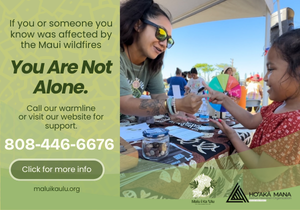Hope For Health
Molokai program helps diabetics cope.
Robert Takeuchi was in denial of his diabetes for 20 years. It wasn’t until two of his friends, who were also diabetic, had their limbs amputated within the same week that he decided to do something about it.
.jpg)
“That was my wake-up call,” he recounts.
Those sobering images prompted the Molokai resident to seek the information he needed to help prolong his life and better manage his disease. He found help in the form of several diabetic programs – the latest proved to be most effective.
Takeuchi, along with about 15 others, recently graduated from Molokai’s first-ever Diabetes Self Management program hosted by Alu Like, Inc., a nonprofit organization that helps Native Hawaiians achieve social and economic self-sufficiency.
“There is a great need on Molokai for a program like this,” said Leslie Tanoue, Alu Like interim director. “Especially with diabetes predominance in native Hawaiians.”
Like Takeuchi, many lack basic knowledge about the potentially life-threatening disease. In the U.S., diabetes is responsible for more deaths each year than breast cancer and AIDS combined. Hawaii’s numbers alone have jumped to 79,000 diabetics in 2008 from the 29,000 estimated in 1994, according to the National Diabetes Surveillance System. Among these numbers, native Hawaiians, Filipinos and Japanese have the highest rate of diabetes than any other ethnicity.
Luckily, this six-week program, based on Stanford University research, focuses on caring for your body, lowering blood sugar levels and improving overall health to help reverse the statistics. Every week, participants and facilitators would meet for two and a half hours to cover various topics. The graduates created action plans that would further help them accomplish both short-term and long-term goals.
Takeuchi’s action plan incorporated walking and exercising into his daily routine, something he had never done before.
“I learned when you walk down the street, you get to meet your neighbors,” Takeuchi joked.
While some saw improvements with their diet and exercise routines, others witnessed critical changes in their blood sugar levels.
“My blood sugar was really high, but it’s dropped since the program,” said Dorothy Quintua, another program graduate.
Quintua has had diabetes for 24 years and at one point, went into a diabetic coma.
“It was very scary,” she said. “I’m getting older and need to be aware of how to take care of myself.”
During the program, Quintua set goals to exercise, eat better, quit drinking soda and avoid eating dinners late. So far, she has accomplished all of them, and shows no sign of slowing down.
“I just have to stay on course,” she added.
The Diabetes Self Management Program, a subdivision of Stanford’s Chronic Disease Self Management Program, will hold continuous class sessions throughout the year. The workshop costs $10 for seniors and caregivers, and $35 for participants under 60 years old. Scholarships are also available.
For more information about upcoming classes or to register, call Kaui Manera or Debbie Benjamin from the Office of Aging at 553-5393.












Don't have a Molokai Dispatch ID?
Sign up is easy. Sign up now
You must login to post a comment.
Lost Password